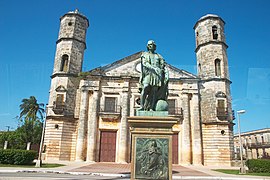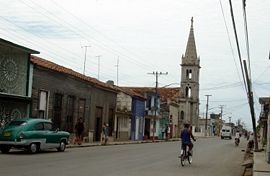Cárdenas (Cuba)
| Cardenas | |
|---|---|
|
Coordinates: 23 ° 3 ′ N , 81 ° 12 ′ W
Cardenas on the map of Cuba
|
|
| Basic data | |
| Country |
|
| province | Matanzas |
| City foundation | 1828 |
| Residents | 143,593 (2012) |
| City insignia | |
| Detailed data | |
| surface | 528.8 |
| Population density | 271.5 inhabitants / km 2 |
| height | 10 m |
| Waters | Florida Street |
| prefix | + 53-45 |
| Time zone | UTC -5 |
| Cardenas Cathedral | |
| Calle Calzada | |
San Juan de Díos de Cárdenas or simply Cárdenas is a city and a municipality in the Matanzas province in Cuba . It borders in the north on the Florida road , in the east on the Municipios Martí and Perico , in the south on Jovellanos , in the southwest on Limonar and in the west on the provincial capital Matanzas . The town of Varadero also belongs to the municipality . The municipality has an area of 528.8 km² and 143,593 people live here (2012 census).
The city was founded in 1828. The population grew thanks to the port, which allowed efficient trade in the agricultural products grown in the region and which is still one of the most important ports in the country. Cárdenas became the main center of sugar production in the country. In 1850, the patriot Narciso López hoisted the flag of Cuba for the first time , which is why the city is also known as Ciudad Bandera ("Flag City ").
Cárdenas is well served by various highways and railway lines. Varadero International Airport is located in the municipality's territory. The extraction of crude oil and natural gas stored in the Bahía de Cárdenas is of further economic importance .
Popular uprising of June 1962
In June 1962, Cárdenas was the site of the first large protest demonstration by the Cuban people against the government under Fidel Castro . Many of the city's residents were unhappy with the effects of communist economic policies and the restrictions on their freedoms. The supply situation had deteriorated significantly since the revolution of 1959 , so the government introduced nationwide food rationing . The main form of protest were street demonstrations by mostly poor black women who hit their empty cooking pots and demanded food and an end to the repression. The Cuban leadership sent soldiers and tanks from other parts of the country to Cárdenas to stifle the protests, there were numerous arrests and four executions of the alleged leaders. The government then deployed the tanks in a military parade, which also included artillery and overflights of fighter planes and was broadcast nationwide on television and radio, including a victory speech by President Osvaldo Dorticós, who had come to Cárdenas . When Castro gave a speech a year later in Cárdenas, he issued warning words to "the counter-revolutionary rag proletariat and its allies from the bourgeoisie " in the province of Matanzas: "A single day is enough to drive out the rag proletariat."
sons and daughters of the town
- Elián González (* 1993), boat refugee
- Gisela Hernández Gonzalo (1912–1971), musicologist and composer
- Danell Leyva (* 1991), American gymnast
- Silvano Pedroso Montalvo (* 1953), Roman Catholic clergyman, Bishop of Guantánamo-Baracoa
- Ernest Sosa (* 1940), philosopher
See also
Web links
- El Municipio de Cárdenas at guije.com (Spanish)
Individual evidence
- ↑ The Hungarian Ambassador's report on his visit to President of the Republic Dorticos ( Memento of the original from December 4, 2013 in the Internet Archive ) Info: The archive link was automatically inserted and not yet checked. Please check the original and archive link according to the instructions and then remove this notice. (PDF). Report of the Hungarian Ambassador to Cuba of June 25, 1962, p. 6f., Accessed via Cold War History Research Center Budapest on December 1, 2013 (English)
- ^ Carlos Franqui: Family Portrait with Fidel. A memoir. Random House, New York 1984, section "The Cárdenas Uprising", pp. 141–144 (English)
- ^ Paul D. Bethel: The Losers. Arlington House, New Rochelle 1969, pp. 319-320 (English)
- ^ Castro Moves Tanks, Troops into Cardenas. In: Herald-Journal of June 17, 1962, accessed via Google News Archive on December 1, 2013 (English)
- ↑ Pedro Álvarez Peña: El Silencio de los Calderos. In: Misceláneas de Cuba of December 19, 2006, accessed December 1, 2013 (Spanish)
- ↑ Fidel Castro: Discurso pronunciado (...) en Cárdenas (...) el 18 de Junio de 1963. On the official website of the Cuban government, accessed on December 1, 2013 (Spanish)



